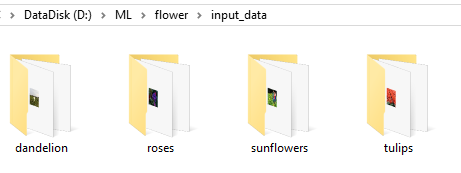CNN实现花卉图片分
前言
本文为一个利用卷积神经网络实现花卉分类的项目,因此不会过多介绍卷积神经网络的基本知识。此项目建立在了解卷积神经网络进行图像分类的原理上进行的。
项目简介
本项目为一个图像识别项目,基于tensorflow,利用CNN网络实现识别四种花的种类。
使用tensorflow进行一个完整的图像识别。项目包括对数据集的处理,从硬盘读取数据,CNN网络的定义,训练过程以及利用实际测试数据对训练好的模型结果进行测试功能。
准备训练数据。
训练数据存放路径为: ‘D:/ML/flower/input_data’
训练模型存储路径为:'D:/ML/flower/save/‘
测试样本路径及文件名为:'D:/ML/flower/flower_photos/roses/**.jpg‘
测试用图片文件从训练数据中任意拷贝一张即可。
训练数据如图

以roses种类的训练数据为例,文件夹内部均为该种类花的图像文件

模块组成
示例代码主要由四个模块组成:
input_data.py——图像特征提取模块,模块生成四种花的品类图片路径及对应标签的List
model.py——模型模块,构建完整的CNN模型
train.py——训练模块,训练模型,并保存训练模型结果
test.py——测试模块,测试模型对图片识别的准确度
项目模块执行顺序
- 运行train.py开始训练。
- 训练完成后- 运行test.py,查看实际测试结果
input_data.py——图像特征提取模块,模块生成四种花的品类图片路径及对应标签的List
import os
import math
import numpy as np
import tensorflow as tf
import matplotlib.pyplot as plt# -----------------生成图片路径和标签的List------------------------------------
train_dir = 'D:/ML/flower/input_data'roses = []
label_roses = []
tulips = []
label_tulips = []
dandelion = []
label_dandelion = []
sunflowers = []
label_sunflowers = []
定义函数get_files,获取图片列表及标签列表
# step1:获取所有的图片路径名,存放到
# 对应的列表中,同时贴上标签,存放到label列表中。
def get_files(file_dir, ratio):for file in os.listdir(file_dir + '/roses'):roses.append(file_dir + '/roses' + '/' + file)label_roses.append(0)for file in os.listdir(file_dir + '/tulips'):tulips.append(file_dir + '/tulips' + '/' + file)label_tulips.append(1)for file in os.listdir(file_dir + '/dandelion'):dandelion.append(file_dir + '/dandelion' + '/' + file)label_dandelion.append(2)for file in os.listdir(file_dir + '/sunflowers'):sunflowers.append(file_dir + '/sunflowers' + '/' + file)label_sunflowers.append(3)# step2:对生成的图片路径和标签List做打乱处理image_list = np.hstack((roses, tulips, dandelion, sunflowers))label_list = np.hstack((label_roses, label_tulips, label_dandelion, label_sunflowers))# 利用shuffle打乱顺序temp = np.array([image_list, label_list])temp = temp.transpose()np.random.shuffle(temp)# 将所有的img和lab转换成listall_image_list = list(temp[:, 0])all_label_list = list(temp[:, 1])# 将所得List分为两部分,一部分用来训练tra,一部分用来测试val# ratio是测试集的比例n_sample = len(all_label_list)n_val = int(math.ceil(n_sample * ratio)) # 测试样本数n_train = n_sample - n_val # 训练样本数tra_images = all_image_list[0:n_train]tra_labels = all_label_list[0:n_train]tra_labels = [int(float(i)) for i in tra_labels]val_images = all_image_list[n_train:-1]val_labels = all_label_list[n_train:-1]val_labels = [int(float(i)) for i in val_labels]return tra_images, tra_labels, val_images, val_labels
定义函数get_batch,生成训练批次数据
# --------------------生成Batch----------------------------------------------# step1:将上面生成的List传入get_batch() ,转换类型,产生一个输入队列queue,因为img和lab
# 是分开的,所以使用tf.train.slice_input_producer(),然后用tf.read_file()从队列中读取图像
# image_W, image_H, :设置好固定的图像高度和宽度
# 设置batch_size:每个batch要放多少张图片
# capacity:一个队列最大多少
定义函数get_batch,生成训练批次数据
def get_batch(image, label, image_W, image_H, batch_size, capacity):# 转换类型image = tf.cast(image, tf.string)label = tf.cast(label, tf.int32)# make an input queueinput_queue = tf.train.slice_input_producer([image, label])label = input_queue[1]image_contents = tf.read_file(input_queue[0]) # read img from a queue# step2:将图像解码,不同类型的图像不能混在一起,要么只用jpeg,要么只用png等。image = tf.image.decode_jpeg(image_contents, channels=3)# step3:数据预处理,对图像进行旋转、缩放、裁剪、归一化等操作,让计算出的模型更健壮。image = tf.image.resize_image_with_crop_or_pad(image, image_W, image_H)image = tf.image.per_image_standardization(image)# step4:生成batch# image_batch: 4D tensor [batch_size, width, height, 3],dtype=tf.float32# label_batch: 1D tensor [batch_size], dtype=tf.int32image_batch, label_batch = tf.train.batch([image, label],batch_size=batch_size,num_threads=32,capacity=capacity)# 重新排列label,行数为[batch_size]label_batch = tf.reshape(label_batch, [batch_size])image_batch = tf.cast(image_batch, tf.float32)return image_batch, label_batchmodel.py——CN模型构建
import tensorflow as tf#定义函数infence,定义CNN网络结构
#卷积神经网络,卷积加池化*2,全连接*2,softmax分类
#卷积层1
def inference(images, batch_size, n_classes):with tf.variable_scope('conv1') as scope:weights = tf.Variable(tf.truncated_normal(shape=[3,3,3,64],stddev=1.0,dtype=tf.float32),name = 'weights',dtype=tf.float32)biases = tf.Variable(tf.constant(value=0.1, dtype=tf.float32, shape=[64]),name='biases', dtype=tf.float32)conv = tf.nn.conv2d(images, weights, strides=[1, 1, 1, 1], padding='SAME')pre_activation = tf.nn.bias_add(conv, biases)conv1 = tf.nn.relu(pre_activation, name=scope.name)# 池化层1# 3x3最大池化,步长strides为2,池化后执行lrn()操作,局部响应归一化,对训练有利。with tf.variable_scope('pooling1_lrn') as scope:pool1 = tf.nn.max_pool(conv1, ksize=[1, 3, 3, 1], strides=[1, 2, 2, 1], padding='SAME', name='pooling1')norm1 = tf.nn.lrn(pool1, depth_radius=4, bias=1.0, alpha=0.001 / 9.0, beta=0.75, name='norm1')# 卷积层2# 16个3x3的卷积核(16通道),padding=’SAME’,表示padding后卷积的图与原图尺寸一致,激活函数relu()with tf.variable_scope('conv2') as scope:weights = tf.Variable(tf.truncated_normal(shape=[3, 3, 64, 16], stddev=0.1, dtype=tf.float32),name='weights', dtype=tf.float32)biases = tf.Variable(tf.constant(value=0.1, dtype=tf.float32, shape=[16]),name='biases', dtype=tf.float32)conv = tf.nn.conv2d(norm1, weights, strides=[1, 1, 1, 1], padding='SAME')pre_activation = tf.nn.bias_add(conv, biases)conv2 = tf.nn.relu(pre_activation, name='conv2')# 池化层2# 3x3最大池化,步长strides为2,池化后执行lrn()操作,# pool2 and norm2with tf.variable_scope('pooling2_lrn') as scope:norm2 = tf.nn.lrn(conv2, depth_radius=4, bias=1.0, alpha=0.001 / 9.0, beta=0.75, name='norm2')pool2 = tf.nn.max_pool(norm2, ksize=[1, 3, 3, 1], strides=[1, 1, 1, 1], padding='SAME', name='pooling2')# 全连接层3# 128个神经元,将之前pool层的输出reshape成一行,激活函数relu()with tf.variable_scope('local3') as scope:reshape = tf.reshape(pool2, shape=[batch_size, -1])dim = reshape.get_shape()[1].valueweights = tf.Variable(tf.truncated_normal(shape=[dim, 128], stddev=0.005, dtype=tf.float32),name='weights', dtype=tf.float32)biases = tf.Variable(tf.constant(value=0.1, dtype=tf.float32, shape=[128]),name='biases', dtype=tf.float32)local3 = tf.nn.relu(tf.matmul(reshape, weights) + biases, name=scope.name)# 全连接层4# 128个神经元,激活函数relu()with tf.variable_scope('local4') as scope:weights = tf.Variable(tf.truncated_normal(shape=[128, 128], stddev=0.005, dtype=tf.float32),name='weights', dtype=tf.float32)biases = tf.Variable(tf.constant(value=0.1, dtype=tf.float32, shape=[128]),name='biases', dtype=tf.float32)local4 = tf.nn.relu(tf.matmul(local3, weights) + biases, name='local4')# dropout层# with tf.variable_scope('dropout') as scope:# drop_out = tf.nn.dropout(local4, 0.8)# Softmax回归层# 将前面的FC层输出,做一个线性回归,计算出每一类的得分with tf.variable_scope('softmax_linear') as scope:weights = tf.Variable(tf.truncated_normal(shape=[128, n_classes], stddev=0.005, dtype=tf.float32),name='softmax_linear', dtype=tf.float32)biases = tf.Variable(tf.constant(value=0.1, dtype=tf.float32, shape=[n_classes]),name='biases', dtype=tf.float32)softmax_linear = tf.add(tf.matmul(local4, weights), biases, name='softmax_linear')return softmax_linear# -----------------------------------------------------------------------------
# loss计算
# 传入参数:logits,网络计算输出值。labels,真实值,在这里是0或者1
# 返回参数:loss,损失值
def losses(logits, labels):with tf.variable_scope('loss') as scope:cross_entropy = tf.nn.sparse_softmax_cross_entropy_with_logits(logits=logits, labels=labels,name='xentropy_per_example')loss = tf.reduce_mean(cross_entropy, name='loss')tf.summary.scalar(scope.name + '/loss', loss)return loss# --------------------------------------------------------------------------
# loss损失值优化
# 输入参数:loss。learning_rate,学习速率。
# 返回参数:train_op,训练op,这个参数要输入sess.run中让模型去训练。
def trainning(loss, learning_rate):with tf.name_scope('optimizer'):optimizer = tf.train.AdamOptimizer(learning_rate=learning_rate)global_step = tf.Variable(0, name='global_step', trainable=False)train_op = optimizer.minimize(loss, global_step=global_step)return train_op# -----------------------------------------------------------------------
# 评价/准确率计算
# 输入参数:logits,网络计算值。labels,标签,也就是真实值,在这里是0或者1。
# 返回参数:accuracy,当前step的平均准确率,也就是在这些batch中多少张图片被正确分类了。
def evaluation(logits, labels):with tf.variable_scope('accuracy') as scope:correct = tf.nn.in_top_k(logits, labels, 1)correct = tf.cast(correct, tf.float16)accuracy = tf.reduce_mean(correct)tf.summary.scalar(scope.name + '/accuracy', accuracy)return accuracytrain.py——利用D:/ML/flower/input_data/路径下的训练数据,对CNN模型进行训练
import input_data
import model# 变量声明
N_CLASSES = 4 # 四种花类型
IMG_W = 64 # resize图像,太大的话训练时间久
IMG_H = 64
BATCH_SIZE = 20
CAPACITY = 200
MAX_STEP = 2000 # 一般大于10K
learning_rate = 0.0001 # 一般小于0.0001# 获取批次batch
train_dir = 'F:/input_data' # 训练样本的读入路径
logs_train_dir = 'F:/save' # logs存储路径# train, train_label = input_data.get_files(train_dir)
train, train_label, val, val_label = input_data.get_files(train_dir, 0.3)
# 训练数据及标签
train_batch, train_label_batch = input_data.get_batch(train, train_label, IMG_W, IMG_H, BATCH_SIZE, CAPACITY)
# 测试数据及标签
val_batch, val_label_batch = input_data.get_batch(val, val_label, IMG_W, IMG_H, BATCH_SIZE, CAPACITY)# 训练操作定义
train_logits = model.inference(train_batch, BATCH_SIZE, N_CLASSES)
train_loss = model.losses(train_logits, train_label_batch)
train_op = model.trainning(train_loss, learning_rate)
train_acc = model.evaluation(train_logits, train_label_batch)# 测试操作定义
test_logits = model.inference(val_batch, BATCH_SIZE, N_CLASSES)
test_loss = model.losses(test_logits, val_label_batch)
test_acc = model.evaluation(test_logits, val_label_batch)# 这个是log汇总记录
summary_op = tf.summary.merge_all()# 产生一个会话
sess = tf.Session()
# 产生一个writer来写log文件
train_writer = tf.summary.FileWriter(logs_train_dir, sess.graph)
# val_writer = tf.summary.FileWriter(logs_test_dir, sess.graph)
# 产生一个saver来存储训练好的模型
saver = tf.train.Saver()
# 所有节点初始化
sess.run(tf.global_variables_initializer())
# 队列监控
coord = tf.train.Coordinator()
threads = tf.train.start_queue_runners(sess=sess, coord=coord)# 进行batch的训练
try:# 执行MAX_STEP步的训练,一步一个batchfor step in np.arange(MAX_STEP):if coord.should_stop():break_, tra_loss, tra_acc = sess.run([train_op, train_loss, train_acc])# 每隔50步打印一次当前的loss以及acc,同时记录log,写入writerif step % 10 == 0:print('Step %d, train loss = %.2f, train accuracy = %.2f%%' % (step, tra_loss, tra_acc * 100.0))summary_str = sess.run(summary_op)train_writer.add_summary(summary_str, step)# 每隔100步,保存一次训练好的模型if (step + 1) == MAX_STEP:checkpoint_path = os.path.join(logs_train_dir, 'model.ckpt')saver.save(sess, checkpoint_path, global_step=step)except tf.errors.OutOfRangeError:print('Done training -- epoch limit reached')finally:coord.request_stop()
test.py——利用D:/ML/flower/flower_photos/roses路径下的测试数据,查看识别效果
import matplotlib.pyplot as plt
import model
from input_data import get_files# 获取一张图片
def get_one_image(train):# 输入参数:train,训练图片的路径# 返回参数:image,从训练图片中随机抽取一张图片n = len(train)ind = np.random.randint(0, n)img_dir = train[ind] # 随机选择测试的图片img = Image.open(img_dir)plt.imshow(img)plt.show()image = np.array(img)return image# 测试图片
def evaluate_one_image(image_array):with tf.Graph().as_default():BATCH_SIZE = 1N_CLASSES = 4image = tf.cast(image_array, tf.float32)image = tf.image.per_image_standardization(image)image = tf.reshape(image, [1, 64, 64, 3])logit = model.inference(image, BATCH_SIZE, N_CLASSES)logit = tf.nn.softmax(logit)x = tf.placeholder(tf.float32, shape=[64, 64, 3])# you need to change the directories to yours.logs_train_dir = 'F:/save/'saver = tf.train.Saver()with tf.Session() as sess:print("Reading checkpoints...")ckpt = tf.train.get_checkpoint_state(logs_train_dir)if ckpt and ckpt.model_checkpoint_path:global_step = ckpt.model_checkpoint_path.split('/')[-1].split('-')[-1]saver.restore(sess, ckpt.model_checkpoint_path)print('Loading success, global_step is %s' % global_step)else:print('No checkpoint file found')prediction = sess.run(logit, feed_dict={x: image_array})max_index = np.argmax(prediction)if max_index == 0:result = ('这是玫瑰花的可能性为: %.6f' % prediction[:, 0])elif max_index == 1:result = ('这是郁金香的可能性为: %.6f' % prediction[:, 1])elif max_index == 2:result = ('这是蒲公英的可能性为: %.6f' % prediction[:, 2])else:result = ('这是这是向日葵的可能性为: %.6f' % prediction[:, 3])return result# ------------------------------------------------------------------------if __name__ == '__main__':img = Image.open('F:/input_data/dandelion/1451samples2.jpg')plt.imshow(img)plt.show()imag = img.resize([64, 64])image = np.array(imag)print(evaluate_one_image(image))项目执行结果:
1.执行train模块,结果如下:

同时,训练结束后,在电脑指定的训练模型存储路径可看到保存的训练好的模型数据。

2.执行test模块,结果如下:
显示一张测试用的图片

关闭显示的测试图片后,console查看测试结果如下:

至此我们对整个项目流程做一个总结:
图片预处理模块:对获得的花卉图片训练数据,进行预处理,构造训练用数据结构
训练模块:利用Tensorflow实现CNN(神经网络算法)模型,经过两层卷积-池化处理,并使用梯度下降算法作为优化器、Softmax算法作为分类器、平方损失函数(最小二乘法, Ordinary Least Squares)作为优化器,构建训练模型,利用训练数据对模型进行训练,最终得到训练后的模型数据,并以文件形式存储至本机。
分类准确度验证模块:利用Tensorflow的reduce_mean方法作为评估模型,对构建的花卉分类模型分类准确性进行验证。
模型测试模块:使用测试集数据,对构建并训练后的分类模型进行测试,验证实际数据的测试准确度。
具体代码以及附件可在我的个人GitHub上下载
我的githubworkspace



